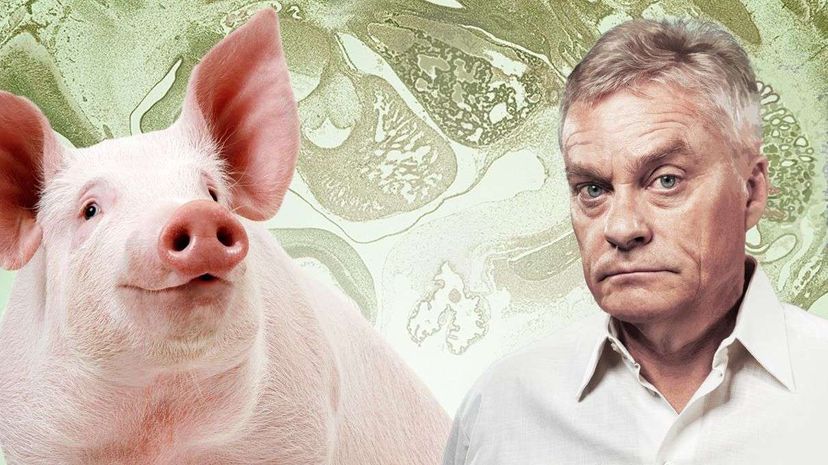 “Should the pig fear the man — or vice versa? De Agostini Picture Library/Digital Zoo/Holloway/Getty
“Should the pig fear the man — or vice versa? De Agostini Picture Library/Digital Zoo/Holloway/Getty
The word "chimera" invokes visions of a beast from Greek mythology that was a hybrid of a lion, goat and dragon and wreaked devastation and death. So when researchers in California say they are creating chimera embryos — placing human stem cells inside the embryos of pigs — you can almost see the National Enquirer headline: "Pig-Man Escapes from California Lab!"
The truth about chimera research is far less sensational, but still controversial. The goal of chimera research isn’t to create a hybrid animal, but to grow human organ tissue inside a pig or sheep. Still, the topic is thorny enough for the National Institutes of Health (NIH) to issue a moratorium (in September 2015) on all funding for projects in which human stem cells are "introduced into non-human vertebrate animal … embryos."
Growing human organs inside a pig sounds bizarre, but it might be our best hope for supplying life-saving organs to the 121,000 Americans currently on an organ transplant waiting list. Twenty-two Americans die each day waiting for a new kidney, liver, lung, heart or pancreas. With the demand for organs greatly outpacing supply, researchers have tried with limited success to grow organs in the lab from human stem cells.
But this in vitro approach has significant limitations, says Henry Greely, a Stanford Law School professor and director of the school’s Center for Law and the Biosciences.
"Even though a pig is a lot different than a human, a pig is a hell of a lot closer to a human than a petri dish," says Greely, who recently wrote an op-ed in the Los Angeles Times calling for an end to the NIH ban on chimera embryos. "Cells react differently in vivo than they do in vitro. It’s both the messages they’re getting from surrounding cells, but also the structures that are around them. Inside bodies, it’s a lot easier for things to grow in three dimensions than it is on a flat petri dish."
What’s The Process Like?
If the chimera embryo process works — and early indications are promising — a patient suffering from Type 1 diabetes could grow a new, custom-made pancreas inside pig. But how does it work?
The process starts with a pluripotent stem cell, an adult cell taken from the patient’s body and reprogrammed to return to its embryonic or "blank" state. Using a powerful microscope, researchers poke a hole in an early-stage pig embryo and insert a synthesized molecule that seeks out and destroys the genes responsible for growing the pig’s own pancreas. In its place, they drop in the human pluripotent stem cell, which has the ability to become any type of human tissue, including a pancreas.
This chimera embryo is then surgically implanted inside the womb of an adult female pig. While the gestation period of a pig is 114 days long, currently a scientist would harvest the embryo at 28 days, the time when primitive organs start to develop. The researcher would then euthanize the embryo and check to see whether a human pancreas was indeed developing. Once that technology has been perfected, it might be possible for a chimera embryo to grow to full-term inside a mother pig and its healthy human pancreas transplanted into a waiting donor.
Is this all a little creepy? Sure. But is it unethical? Stanford’s Greely doesn’t think so.
"If you tried to make a human brain inside a pig, that would bother me," says Greely. "But if you’re trying to make a human pancreas or human kidney or human liver inside a pig, I don’t think very many people are going to be bothered by that. Hundreds of thousands of people are alive today because they’ve received heart valves that were either taken directly from pigs or carved from cattle cartilage."
Ethical Concerns
So why is the NIH taking such a strong stance against chimera embryo research if it might result in life-saving medical innovation? Greely attended a NIH public workshop in November where researchers, bioethicists and animal care specialists convened to discuss the funding moratorium, but instead of getting answers, "I came away only with vague comments about ‘controversies’ and ‘political concerns,’" he says.
NIH’s associate director for science policy, Carrie Wolinetz told NPR that the moratorium was prompted by the increasing requests to fund these types of experiments. She said the NIH wanted to "make sure that we are fully prepared from a policy and guidance point of view" before making decisions about funding this research.
Some bioethicists are concerned about human stem cells ending up in a pig’s brain or sperm or eggs, which theoretically could mean a pig with a human consciousness or a human fetus developing inside a chimeric pig. Since the current experiments only allow gestation periods of 28 days, none of these scenarios are likely to occur now. Plus, human and animal brains are so different, an animal gaining human consciousness is very unlikely even if human stem cells were added to the mix, scientists say.
Ironically, by choosing not to fund chimera research, the NIH might be opening a Pandora’s box of private funding sources unchecked by federal oversight.
"One of the real lessons of the last 40 years of biomedical research is that with funding comes some control," says Greely. "If you don’t fund something, maybe that means it doesn’t happen, in which case you don’t have to worry about it. But maybe it means it happens in way that you now have no control over."
Which brings us back to Mr. Pig-Man.
Now That’s Cool
In 1984, researchers at the Institute of Animal Physiology in Cambridge, England successfully mingled embryos to create the world’s first "geep," a lab-produced chimera of a goat and sheep.


